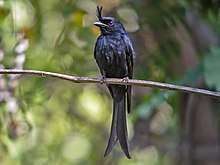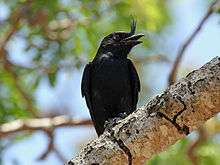Crested drongo
The crested drongo (Dicrurus forficatus) is a passerine bird in the family Dicruridae. It is black with a bluish-green sheen, a distinctive crest on the forehead and a forked tail. There are two subspecies; D. f. forficatus is endemic to Madagascar and D. f. potior, which is larger, is found on the Comoro Islands. Its habitat is lowland forests, both dry and humid, and open savannah country. It is a common bird and the IUCN has listed it as "least concern".
| Crested drongo | |
|---|---|
 | |
 | |
| Scientific classification | |
| Kingdom: | Animalia |
| Phylum: | Chordata |
| Class: | Aves |
| Order: | Passeriformes |
| Family: | Dicruridae |
| Genus: | Dicrurus |
| Species: | D. forficatus |
| Binomial name | |
| Dicrurus forficatus (Linnaeus, 1766) | |
| Subspecies | |
| |
| Synonyms | |
|
Lanius forficatus Linnaeus, 1766 | |
Taxonomy
In 1760 the French zoologist Mathurin Jacques Brisson included a description of the crested drongo in his Ornithologie based on a specimen collected in Madagascar. He used the French name Le grand gobe-mouche noir hupé de Madagascar and the Latin Muscicapa Madagascariensis nigra major cristata.[2] Although Brisson coined Latin names, these do not conform to the binomial system and are not recognised by the International Commission on Zoological Nomenclature.[3] When in 1766 the Swedish naturalist Carl Linnaeus updated his Systema Naturae for the twelfth edition, he added 240 species that had been previously described by Brisson.[3] One of these was the crested drongo. Linnaeus included a brief description, coined the binomial name Lanius forficatus and cited Brisson's work.[4] The specific name forficatus is New Latin for "scissor-shaped".[5] This species is now placed in the genus Dicrurus that was introduced by French ornithologist Louis Jean Pierre Vieillot in 1816.[6]
Two subspecies are recognised:[7]
Description
The adult male and female are almost entirely black, with a blue-green sheen. The distinctive crest consists of elongated feathers on the forehead. The forked tail is also distinctive of the adult birds. D. f. potior is larger and has broader tail feathers.[8]
Distribution and habitat
The nominated race is endemic to Madagascar, and found throughout the island, and some of the larger inshore islands including Nosy-Bé. The Dicrurus forficatus potior subspecies on only found on the Comoro Islands.[8]
Its natural habitats are subtropical or tropical dry forest, subtropical or tropical moist lowland forest, and dry savanna, typically below 1,000 meters.[8]
- With a frog, Mantadia National Park, Madagascar
 With an insect
With an insect Egg
Egg_feeding.jpg) feeding chicks, Analamazaotra Special Reserve
feeding chicks, Analamazaotra Special Reserve
References
- BirdLife International (2012). "Dicrurus forficatus". IUCN Red List of Threatened Species. 2012. Retrieved 26 November 2013.CS1 maint: ref=harv (link)
- Brisson, Mathurin Jacques (1760). Ornithologie, ou, Méthode contenant la division des oiseaux en ordres, sections, genres, especes & leurs variétés (in French and Latin). Volume 2. Paris: Jean-Baptiste Bauche. pp. 388–389, Plate 37 fig 4. The two stars (**) at the start of the section indicates that Brisson based his description on the examination of a specimen.
- Allen, J.A. (1910). "Collation of Brisson's genera of birds with those of Linnaeus". Bulletin of the American Museum of Natural History. 28: 317–335.
- Linnaeus, Carl (1766). Systema naturae : per regna tria natura, secundum classes, ordines, genera, species, cum characteribus, differentiis, synonymis, locis (in Latin). Volume 1, Part 1 (12th ed.). Holmiae (Stockholm): Laurentii Salvii. p. 134.
- Jobling, J.A. (2018). del Hoyo, J.; Elliott, A.; Sargatal, J.; Christie, D.A.; de Juana, E. (eds.). "Key to Scientific Names in Ornithology". Handbook of the Birds of the World Alive. Lynx Edicions. Retrieved 20 June 2018.
- Vieillot, Louis Jean Pierre (1816). Analyse d'une Nouvelle Ornithologie Elementaire (in French). Paris: Deterville/self. p. 41.
- Gill, Frank; Donsker, David, eds. (2018). "Old World sparrows, snowfinches, weavers". World Bird List Version 8.1. International Ornithologists' Union. Retrieved 21 June 2018.
- Safford, Roger; Hawkins, Frank (2013). The Birds of Africa: Volume VIII. Bloomsbury Publishing. pp. 848–849. ISBN 978-0-7136-6532-1.
